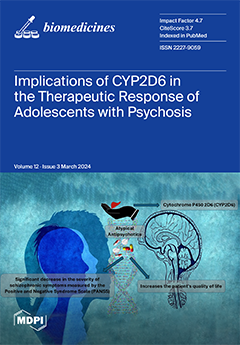Background: Periodontitis and post-menopausal osteoporosis include common chronic bone disorders worldwide, with similar etiopathogenetic events. This study evaluated the effect of systemic melatonin administration on the alveolar bone destruction of periodontitis progression in an experimental periodontitis model in osteoporotic rats. Methods: Forty-four Wistar
[...] Read more.
Background: Periodontitis and post-menopausal osteoporosis include common chronic bone disorders worldwide, with similar etiopathogenetic events. This study evaluated the effect of systemic melatonin administration on the alveolar bone destruction of periodontitis progression in an experimental periodontitis model in osteoporotic rats. Methods: Forty-four Wistar rats were randomly divided into six experimental groups: control (C;
n = 6); osteoporosis (O;
n = 6); ligated periodontitis (LP;
n = 8); osteoporosis- and periodontitis-induced (O+LP;
n = 8); osteoporosis- and periodontitis-induced through 30 mg/kg/day melatonin administration (ML30;
n = 8); and osteoporosis- and periodontitis-induced through 50 mg/kg/day melatonin administration (ML50;
n = 8). The rats underwent bilateraloophorectomy and were maintained for 4 months to induce osteoporosis. After 4 months, 4-0 silk ligatures were placed submarginally around the mandibular first molar of each rat to induce experimental periodontitis, and melatonin was administered in the ML30 and ML50 groups for 30 days. Changes in alveolar bone levels were clinically measured, and tissues were histopathologically examined. Results: Osteoclastic activity in the LP and O+LP groups was significantly higher than in the other groups (
p < 0.05), but was similar in the C, O, and ML30 groups (
p > 0.05). RANKL activity was the highest in the O+LP group, while melatonin decreased RANKL activity in the melatonin-administered groups (
p < 0.05). Systemically administered melatonin significantly decreased alveolar bone loss in the ML30 and ML50 groups compared with that in the periodontitis groups (
p < 0.05). Conclusions: Melatonin inhibited alveolar bone destruction by decreasing the RANKL expression and inflammatory cell infiltration and increased osteoblastic activity in a rat model with osteoporosis and periodontitis.
Full article






